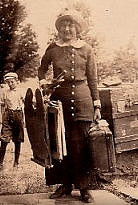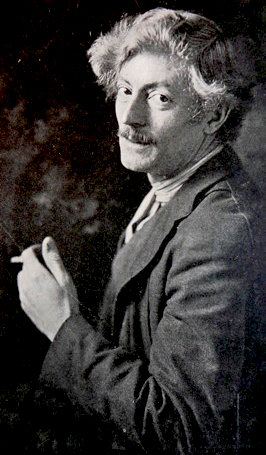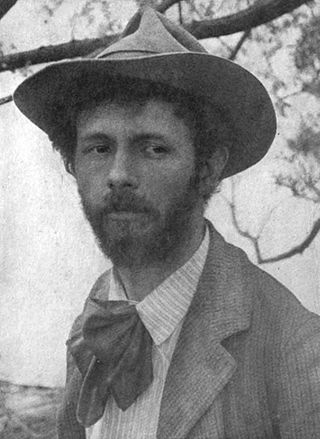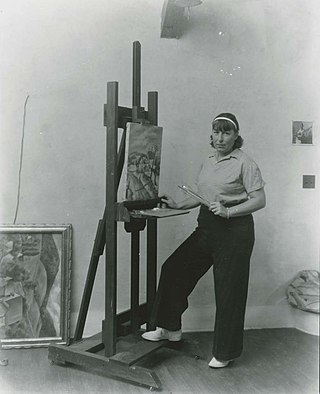
Art colonies are organic congregations of artists in towns, villages and rural areas, who are often drawn to areas of natural beauty, the prior existence of other artists, art schools there, or a lower cost of living. They are typically mission-driven planned communities, which administer a formal process for awarding artist residencies. A typical mission might include providing artists with the time, space, and support to create, fostering community among artists, and providing arts education, including lectures and workshops.
Alf Evers was an American historian who lived in Ulster County, New York for much of his life and wrote lengthy, definitive histories of the Catskills and Woodstock, serving the latter as town historian. At the time of his death his history of Kingston was nearly complete and awaited publication.

Olana State Historic Site is a historic house museum and landscape in Greenport, New York, near the city of Hudson. The estate was home to Frederic Edwin Church (1826–1900), one of the major figures in the Hudson River School of landscape painting. The centerpiece of Olana is an eclectic villa which overlooks parkland and a working farm designed by the artist. The residence has a wide view of the Hudson River Valley, the Catskill Mountains and the Taconic Range. Church and his wife Isabel (1836–1899) named their estate after a fortress-treasure house in ancient Greater Persia, which also overlooked a river valley.
Frank Swift Chase was an American Post-Impressionist landscape painter and a founder of the Woodstock Artists Association in Woodstock, New York, the art colony at Nantucket, Massachusetts, and the Sarasota School of Art in Florida.
Edward Leigh Chase (1884–1965) was an American painter and illustrator, and an early member of the Byrdcliffe experiment which gave rise to the artists' colony at Woodstock, New York. A gifted sketch artist and watercolorist, he was one of the group of young Art Students League humorists who called themselves the Fakirs.

Anita M. Smith was an impressionist and regionalist painter most closely associated with Woodstock, New York. In the 1930s Smith became an herbalist, and her venture, Stonecrop Gardens, was one of only five enterprises of like size in the Northeast, serving clients in every one of the 48 contiguous states. During this phase of her career, she authored and published As True as the Barnacle Tree, a short herbal based on ancient and contemporary practices. In the 1950s she wrote the town of Woodstock's first history, Woodstock History and Hearsay.
This article brings together lists of artists, locations, artistic productions and movements associated with upstate New York.
Woodstock Revisited is a 2009 documentary film by David McDonald that tells the story of how the countercultural movement associated with The Woodstock Festival came into being.
Ralph Radcliffe Whitehead was an English philanthropist and the founder and chief benefactor of the Byrdcliffe Arts and Crafts Colony located in Woodstock, New York.

Maverick Concert Hall was built in 1916 and was part of the Maverick Artist Colony in Hurley, New York.

Woodstock is a town in Ulster County, New York, United States, in the northern part of the county, northwest of Kingston. It lies within the borders of the Catskill Park. The population was 6,287 at the 2020 census, up from 5,884 in 2010.

Dawson Dawson-Watson (1864–1939) was a British-born Impressionist painter who became famous in 1927 for winning the largest cash prize in American art, the Texas Wildflower Competitive Exhibition. He was one of the first members of the famous Impressionist colony in Giverny, France and was a prominent teacher in Hartford, Connecticut, St. Louis, Missouri and San Antonio, Texas.

Hervey White (1866–1944) was an American novelist, poet, and community-builder. He was one of the original founders of the Byrdcliffe Colony in Woodstock, New York, then went on to create a more radical artists' colony, the Maverick. Both Byrdcliffe and the Maverick are part of what is today called the Woodstock Art Colony.

Bolton Coit Brown was an American painter, lithographer, and mountaineer. He was one of the original founders of the Byrdcliffe Colony in Woodstock, NY, part of what is now referred to as the Woodstock Art Colony.

Martha Dewing Woodward (1856–1950) was an American artist and art teacher. According to her obituary in The New York Times, she was "one of the nation's leading painters." Among her accomplishments, she founded the first art school in Provincetown, Massachusetts, in 1896. In 1907, Woodward and her partner, Louise Johnson, founded the Blue Dome Fellowship in Woodstock, New York, which Woodward continued in Florida after her move there. Woodward's art and teachings thrived in Florida, where her work had a lasting impact.
Voice Theatre is a regional theater company located in Woodstock, New York and uses the Byrdcliffe Theater to stage its productions during their season. Director and playwright, Shauna Kanter, has been its artistic director since its inception.

Nan Mason was a painter and photographer.
Zulma Steele (1881–1979) was one of the pioneering women of the Arts and Crafts movement and Modernism in New York. American arts journalist for the New York Times Grace Glueck noted that Steele was a "progressive-minded artist and artisan whose work was considered avant-garde." She married a farmer, Nielson Parker, in 1926. After he died in 1928, Steele traveled extensively in Europe, Haiti, and the Bahamas. She returned to upstate New York and died in New Jersey at 98 years of age.

Jane Byrd McCall Whitehead (1858–1955) was an American artist, photographer and aesthete.
The Elverhoj Art Colony, originally known as the Elverhoj Colony of Artists and Craftsmen, was founded in 1912 in Milton-on-Hudson, New York, by Danish-American artists A. H. Andersen and Johannes Morton. The name is an Anglization of the Danish word Elverhøj, which is the title of a fairytale by Hans Christian Andersen and of the first Danish national play, commissioned by King Frederick VI in 1828.















